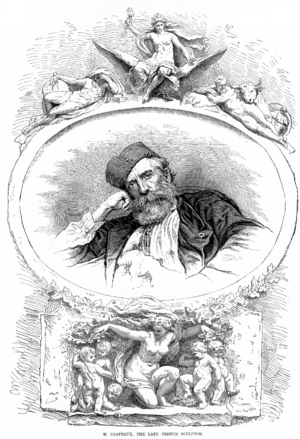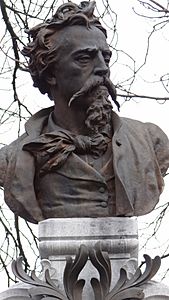Jean-Baptiste Carpeaux facts for kids
Quick facts for kids
Jean-Baptiste Carpeaux
|
|
|---|---|

Illustration of Carpeaux by Étienne Bocourt in the Illustrated Sporting and Dramatic News, after his death. His Flore is below him, and Imperial France protecting Agriculture and Sciences above
|
|
| Born | 11 May 1827 |
| Died | 12 October 1875 (aged 48) Bécon-les-Bruyères (Courbevoie), France
|
| Nationality | French |
| Known for | Sculpture, painting |
|
Notable work
|
La Fontaine des quatre parties due monde Triomphe de Flore Le Génie de la Danse Le Pécheur napolitain La Frileuse |
| Patron(s) | Jean-Baptiste Foucart |
Jean-Baptiste Carpeaux (born May 11, 1827, died October 12, 1875) was a famous French sculptor and painter. He lived during a time in France called the Second Empire, when Napoleon III was the emperor. Carpeaux is known for his lively and emotional sculptures. He often showed people in motion, which was different from the more traditional art of his time.
Contents
Life of a Sculptor
Early Life and Training
Jean-Baptiste Carpeaux was born in Valenciennes, France. His father was a mason, which is a builder who works with stone. Carpeaux began his art studies with François Rude, another well-known sculptor.
In 1844, Carpeaux joined the École des Beaux-Arts (School of Fine Arts) in Paris. This was a very important art school. In 1854, he won the Prix de Rome, a famous art prize. This prize allowed him to study in Rome, Italy, for several years.
Studying in Rome
From 1854 to 1861, Carpeaux lived in Rome. There, he studied the works of great Italian artists like Michelangelo, Donatello, and Verrocchio. He learned to create art with a sense of movement and naturalness. He also admired the grand style of baroque art.
Carpeaux liked to find real people and scenes in the streets of Rome for his art. This was a new approach, as many artists at the time followed strict classical rules. He once said that artists should look to Michelangelo for inspiration, "as with the rays of the sun."
Famous Works and Royal Connections
Carpeaux first showed his art at the Salon in Paris in 1853. This was a big art exhibition. His first piece, a plaster sculpture called La Soumission d'Abd-el-Kader al'Empereur, did not get much attention.
Carpeaux admired Emperor Napoleon III. He followed the emperor on a trip through northern France. He finally met Napoleon III in Amiens and convinced him to order a marble statue.
The Neapolitan Fisherboy
While studying in Rome, Carpeaux created a plaster sculpture called Pêcheur napolitain à la coquille, or The Neapolitan Fisherboy. He later carved a marble version, which was shown at the Salon in 1863.
This statue of a smiling young boy was very popular. Empress Eugénie, Napoleon III's wife, bought it. Carpeaux made many copies and versions of this statue in marble and bronze. You can find a copy in the National Gallery of Art in Washington, D.C. Later, he made a similar sculpture called Girl with a Shell.
Later Career and Legacy
In 1861, Carpeaux created a sculpture of Princess Mathilde. This led to more important art orders from Emperor Napoleon III. In 1866, he opened his own workshop to create larger sculptures and make copies of his popular works.
In 1866, Carpeaux was honored with the Legion of Honour. This is a very high award in France. He worked with his brother, who helped sell his art. Carpeaux wanted his art to be enjoyed by many people.
Jean-Baptiste Carpeaux died on October 12, 1875, at a castle near Paris. Some of his students became famous sculptors themselves, including Jules Dalou and Olin Levi Warner.
Notable Sculptures
- Ugolino and His Sons (1861): This powerful sculpture shows a dramatic scene. You can see versions of it in the Metropolitan Museum of Art in New York and the Musée d'Orsay in Paris.
- The Dance (1869): This lively group of figures was made for the outside of the Palais Garnier, the famous opera house in Paris.
- Neapolitan Fisherboy (Pêcheur à la coquille): A well-known sculpture of a young boy, with a copy in the Musée du Louvre in Paris.
- Young girl with a shell: A similar sculpture to the Fisherboy, located in Valenciennes.
- Antoine Watteau monument: A monument dedicated to the painter Antoine Watteau in Carpeaux's hometown of Valenciennes.
- Flora (1865): This sculpture and other detailed carvings were made for the southern side of the Pavillon de Flore at the Palais du Louvre in Paris.
- City Hall of Valenciennes (1860–1873): Carpeaux created a large group of figures for the top of his hometown's City Hall.
- Fontaine de l'Observatoire (Carpeaux Fountain): This fountain is located south of the Jardin du Luxembourg in Paris. Carpeaux designed the globe at the top, with four figures representing the continents: Asia, Europe, America, and Africa. He did not fully finish it before he died.
- L'Amour à la folie (1869): This sculpture is part of the larger La Danse group for the Opera Garnier.
Images for kids
-
Ugolino and His Sons, 1857–1860. Photographed at the Metropolitan Museum of Art
See also
 In Spanish: Jean-Baptiste Carpeaux para niños
In Spanish: Jean-Baptiste Carpeaux para niños




